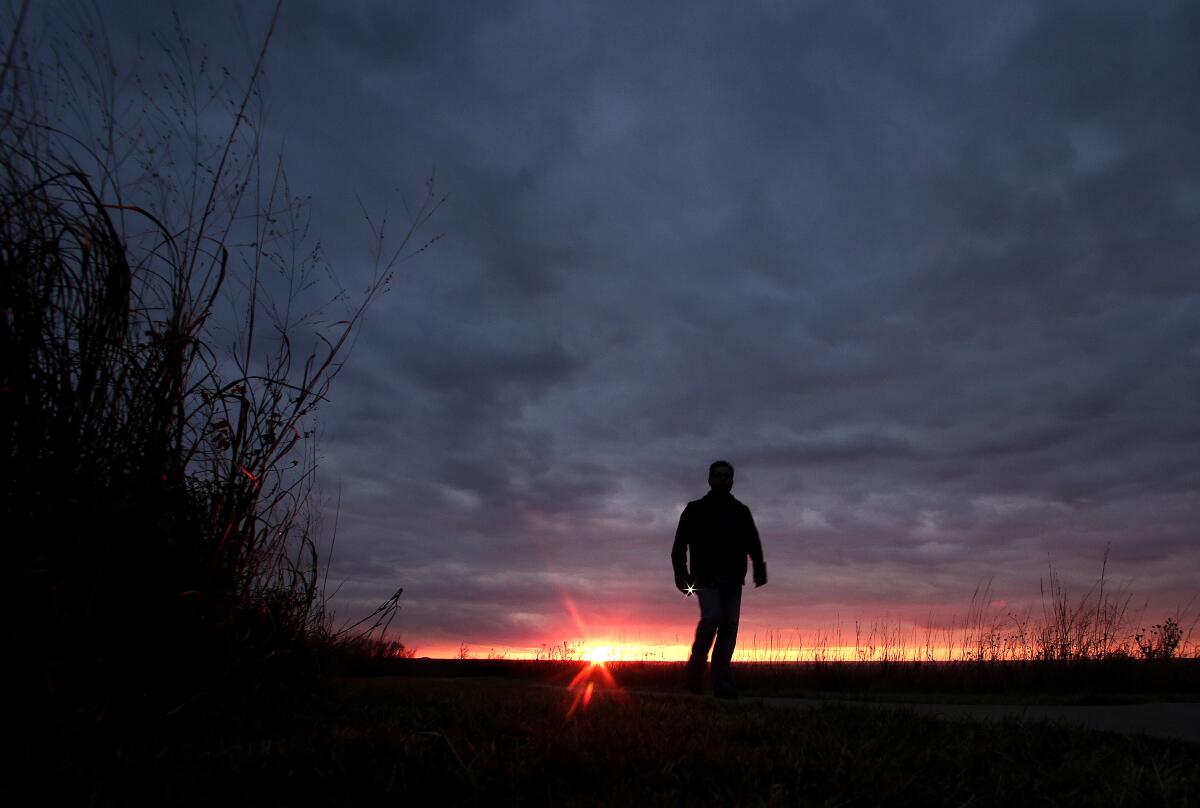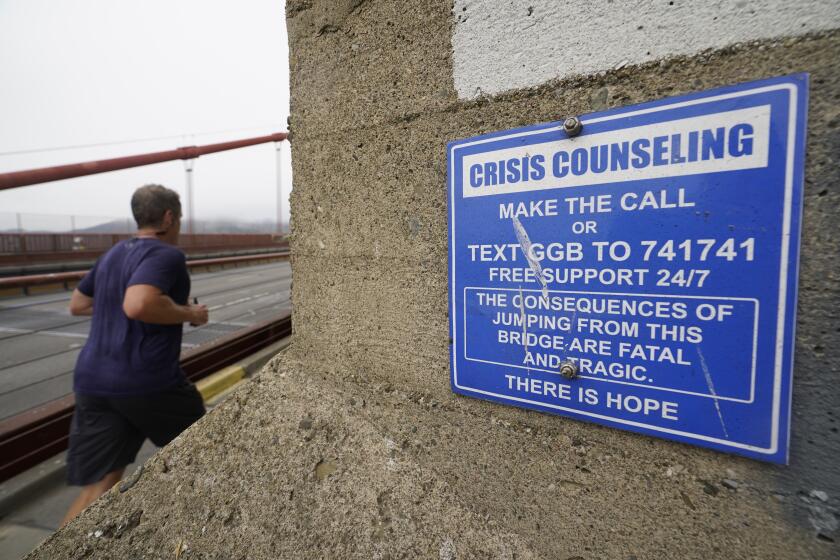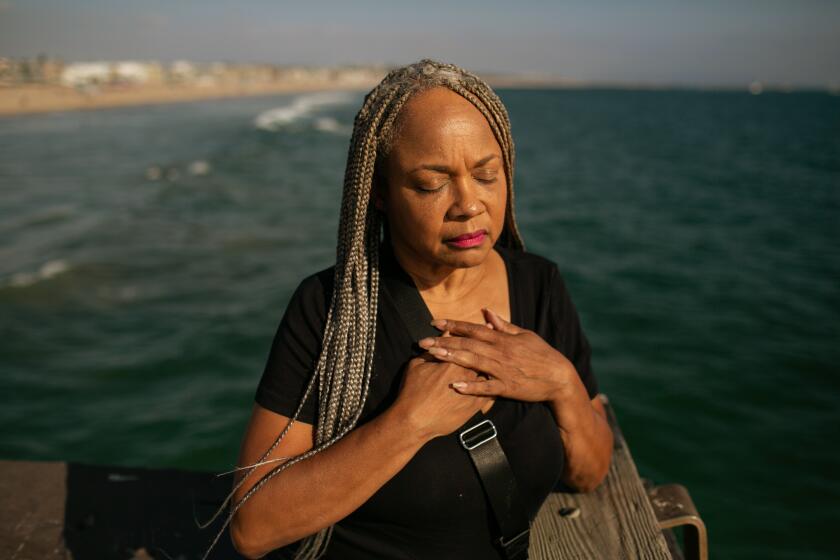U.S. suicides hit an all-time high last year, the CDC reports

NEW YORK — About 49,500 people took their own lives last year in the U.S., the highest number ever, according to new government data posted Thursday.
The Centers for Disease Control and Prevention, which posted the numbers, has not yet calculated a suicide rate for the year, but available data suggest suicides are more common in the U.S. than at any time since the dawn of World War II.
“There’s something wrong. The number should not be going up,” said Christina Wilbur, a 45-year-old Florida woman whose son shot himself to death last year.
“My son should not have died,” she said. “I know it’s complicated, I really do. But we have to be able to do something. Something that we’re not doing. Because whatever we’re doing right now is not helping.”
Experts say recent increases might be driven by a range of factors, including higher rates of depression and limited availability of mental health services.
Suicide prevention and crisis counseling resources
If you or someone you know is struggling with suicidal thoughts, seek help from a professional and call 9-8-8. The United States’ first nationwide three-digit mental health crisis hotline 988 will connect callers with trained mental health counselors. Text “HOME” to 741741 in the U.S. and Canada to reach the Crisis Text Line.
But a main driver is the growing availability of guns, said Jill Harkavy-Friedman, senior vice president of research at the American Foundation for Suicide Prevention.
Suicide attempts involving guns end in death far more often than those with other means, and gun sales have boomed — placing firearms in more and more homes.
A recent Johns Hopkins University analysis used preliminary 2022 data to calculate that the nation’s overall gun suicide rate rose last year to an all-time high. For the first time, the gun suicide rate among Black teens surpassed the rate among white teens, the researchers found.
“I don’t know if you can talk about suicide without talking about firearms,” Harkavy-Friedman said.
U.S. suicides steadily rose from the early 2000s until 2018, when the national rate hit its highest level since 1941. That year saw about 48,300 suicide deaths — or 14.2 for every 100,000 Americans.
The rate fell slightly in 2019. It dropped again in 2020, during the first year of the COVID-19 pandemic. Some experts tied that to a phenomenon seen in the early stages of wars and natural disasters, when people pull together and support one another.
My hope is that by thoughtfully exploring a topic fraught with stigma and misunderstanding, we can all better support our friends and family who experience depression.
But in 2021, suicides rose 4%. Last year, according to the new data, the number jumped by more than 1,000, to 49,449 — about a 3% increase versus the year before. The provisional data come from U.S. death certificates and are considered almost complete, but they may change slightly as death information is reviewed in the months ahead.
The largest increases were seen in older adults. Deaths rose nearly 7% in people ages 45 to 64, and more than 8% in people 65 and older. White men, in particular, have very high rates, the CDC said.
Many middle-aged and elderly people experience problems such as losing a job or losing a spouse, and it’s important to reduce stigma and other obstacles to them getting assistance, said Dr. Debra Houry, the CDC’s chief medical officer.
Suicides in adults ages 25 to 44 grew about 1%. The new data indicate that suicide became the second leading cause of death in that age group in 2022, up from No. 4 in 2021.
There’s a new three-digit phone number for you to remember: 988. It’s a free suicide prevention hotline for anyone to use, and it couldn’t come soon enough.
Despite the grim statistics, some say there is reason for optimism. A national crisis line was launched a year ago; anyone in the U.S. can dial 988 to reach mental health specialists.
The CDC is expanding a suicide program to fund more prevention work in different communities. And there’s growing awareness of the issue and that it’s OK to ask for help, health officials say.
There was a more than 8% drop in suicides by people ages 10 to 24 in 2022. That may be due to increased attention to youth mental health issues and a push for schools and others to focus on the problem, CDC officials said.
But even the smaller number masks tragedy for families.
In the last 19 months, Deneen Vaughn and her family found a way to speak out about what, for many Black families, is the unspeakable.
Christina Wilbur lost her 21-year-old son, Cale, on June 16 last year. He died in her home in Land O’ Lakes, Fla.
Cale Wilbur had lost two friends and an uncle to suicide and had been dealing with depression. On that horrible morning, he and his mother were having an argument. She had confronted him about his drug use, his mother said. She left his bedroom and when she returned he had a gun.
“I was begging him not to, and to calm down,” she said. “It looked like he relaxed for a second, but then he killed himself.”
She describes her life since as a black hole of emptiness and sorrow, and had found it hard to talk to friends or even family about Cale.
One man’s death may not have been preventable, but understanding what led to it offers hope for others.
“There’s just this huge 6-foot-2 hole, everywhere,” she said. “Everything reminds me of what’s missing.”
It’s hard to find professionals to help, and those who are available can be expensive, she said. She turned to support groups, including an organization called Alliance of Hope for Suicide Loss Survivors that operates a 24/7 online forum.
“There’s nothing like being with people who get it,” she said.
More to Read
Sign up for Essential California
The most important California stories and recommendations in your inbox every morning.
You may occasionally receive promotional content from the Los Angeles Times.














